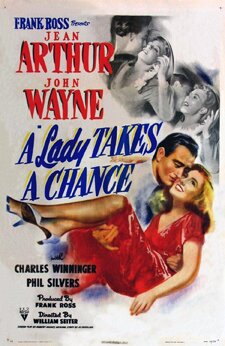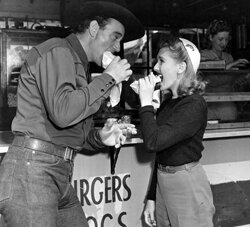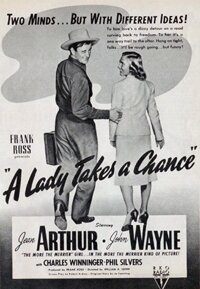 Directed by William A. Seiter
Directed by William A. Seiter
The few references and reviews you’ll find online about A Lady Takes a Chance (1943) tend to make the same observation: a pretty good romantic comedy that few people today have seen.
The movie did pretty well in 1943 – I believe it was the third highest grosser that year. It’s also seldom referred to, or even seen, by those interested in John Wayne.
Its seeming obscurity lies in the fact that it was not a studio produced film but independently produced, or at least partially so. It was intended as a Jean Arthur vehicle, produced by her husband at the time, Frank Ross.
The movie itself is pretty standard escapist fare for the period. (It came out during the Second World War.) In his biography Jean Arthur: The Actress Nobody Knew, John Oller refers to the movie as “more warm than funny,” and that’s a good assessment. I’d add, however, that there was a least one scene that had me laughing out loud.
The movie manages to rise above its somewhat mediocre ambitions thanks to two key elements: Jean Arthur and John Wayne.

It’s a fish-out-of-water story. Arthur as Molly J. Truesdale is an urban working girl, popular with the boys, and the object of the affections of three aspiring beaus, none of whom she is enthused about. She is headed on a bus trip west, a tour. She wants to expand her horizons.
The fish-out-of-water element begins almost immediately with the bus – its riders and their guide (a rather annoying Phil Silvers) are not the usual thing for Molly.
Eventually she find herself in the west attending a rodeo where she meets John Wayne as cowboy Duke Hudkins. Not only is he completely un-urban, he’s unlike any of the men Molly has known. He can take her or leave her. And unlike her men back east, he is emphatic in his desire to remain unhitched – to anyone. (He makes a minor exception for his horse.) Duke won’t be tied down by anyone or any thing.
As you can probably tell, it’s not a storyline that would win awards for originality.
Where it excels is in Arthur and Wayne. Some say Jean Arthur was miscast as she was a bit too old for the role of a young Molly. While this is probably true, strictly speaking, I found her casting worked wonderfully. There is nothing realistic in this film or films of this kind, so the age aspect doesn’t bother me. And surely no one plays a quirky, headstrong character with such masterful timing as Jean Arthur.
She also moves seamlessly from comedic moments to dramatic ones. And then there is the famous Jean Arthur voice which, if you haven’t heard it, you’ve missed out on one of the great pleasures of older movies.

John Wayne also brings a wonderful portrayal to the movie. It’s an early take on the cowboy role he would own and play endlessly, but it’s also that role done with comedy in mind, something we didn’t see very often and that he was pretty clearly quite good at. His rural characterization set against Arthur’s urban characterization make for a clash perfect for comedy.
Overall, this won’t be seen as one of the great comedies or even close. But it’s a pleasurable find nonetheless and certainly one any fan of either Jean Arthur or John Wayne should see. The movie’s parts are brilliant. Unfortunately the whole falls short of their level. But it’s fun!
If I have one complaint about this movie it would be with the copy I have: the Republic Pictures’ release on DVD. I don’t know if there is a cleaner version available anywhere but this one is adequate at best. However, the movie itself quickly makes you forget its limitations.
The image is soft and apparently without any kind of restoration effort made. Or so it seemed to my eyes.



2 Responses